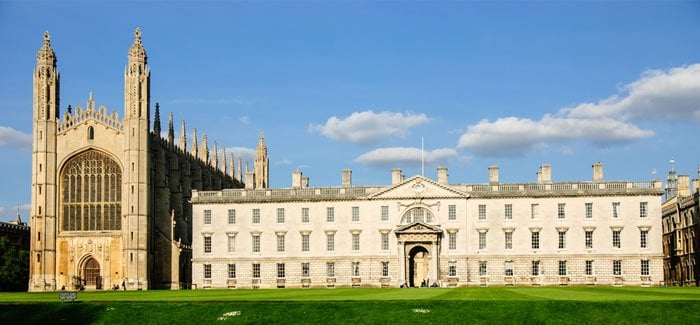As the UK’s oldest and most famous universities, Oxford and Cambridge share a historic rivalry which dates back more than 800 years. The two halves of “Oxbridge” may have many elements in common – residential colleges, tutorial-based teaching, centuries of tradition – but as any graduate from Oxford or Cambridge will tell you that’s where the similarities end.
When it comes to choosing which universities to apply to, applicants through the UK’s Universities and Colleges Admissions Service (UCAS) can only pick one of Oxford and Cambridge, so getting that decision right is crucial.
So, which one will you choose?

QS World University Rankings® 2018
The University of Cambridge outranks Oxford in the QS World University Rankings® 2018, but only marginally. It’s important to remember that, at this level, the differences between institutions are generally very minor – and as longstanding members of the global top 10, both Oxford and Cambridge are firmly established among the world’s higher education elite.
The Oxbridge brand is extremely strong, with both halves of Oxbridge getting high ratings in QS’s international surveys of academics and employers. In the latest results, Cambridge comes out second in the world for academics and first for employers. Oxford, meanwhile, claims the world’s second-highest rating from graduate employers, and is ranked fourth by academics. In short: if you want to study at a university with a solid international reputation, a degree from either Oxford or Cambridge is hard to beat.
Cambridge has a slightly stronger score for citations per faculty member – an indicator which aims to reflect the influence attained by research produced at each institution – though Oxford is not too far behind. Meanwhile Oxford takes the lead when it comes to faculty-student ratio (number of students per academic staff member), but both are within the global top 10 here, and are renowned for their commitment to small group teaching and individual supervision.
In terms of international diversity, both Oxford and Cambridge again get high scores. Unsurprisingly, both are popular destinations for academics and students from around the world. Oxford takes the lead both for its percentage of international faculty members and percentage of international students, although Cambridge is not far behind in either indicator, placing in the global top 100 for both.
Subject strengths
A look at the QS World University Rankings by Subject confirms both Oxford and Cambridge are among the world’s leaders across a comprehensive range of fields. In the most recent edition, Oxford features in the subject rankings in a total of 38 out of a possible 48 subjects, while Cambridge makes 39 appearances. As you can see by the table below, both universities boast top 10 positions for the vast majority of the subjects they feature in.

Location
Oxford is technically a city and Cambridge a town, but in fact both are relatively small and compact places to live, easily navigable on foot or (as is very popular) by cycling.
Highly picturesque, they’re both characterized by attractive historic architecture and rivers running through the city centers, where you’ll find students in training for inter-college rowing contests or the annual Oxford-Cambridge boat race. The latter is perhaps the one day each year when Oxbridge rivalry becomes the most heated.
Oxford and Cambridge are also both close to the UK capital. London is about an hour on the train from Oxford, and slightly under an hour from Cambridge. In terms of differences between the two locations, there’s a general consensus that Cambridge is a little prettier, while Oxford has a bit more going on – but of course this may depend on who you ask.
Fees & living costs
Both Oxford and Cambridge charge different tuition fees depending on whether students are from within the European Union or not. The result of the UK’s EU referendum has meant EU students may be concerned about whether their tuition fees will increase during their course. However, both Oxford and Cambridge have said that current students and students admitted in the 2017-2018 academic year will continue to pay the current home/EU rate for the duration of their program.
The following table gives a rough overview of how much you can expect to pay per year, depending on your study level and nationality. Check the university websites for exact rates, and bear in mind there is significant variation in the amount charged for postgraduate courses, and for non-EU students on undergraduate courses, depending on the subject.
Overseas students will also be charged an additional “college fee”, which also applies to UK/EU students who are not enrolling on their first publicly funded degree. This is currently between £6,850 and £12,700 (depending on the college) per year for overseas undergraduates at Cambridge, and £7,570 per year for overseas undergraduates at Oxford.
In addition to course fees, Oxford advises students to allow between £12,028 and £17,649 (~US$16,670 – 24,500) per year for living costs, including accommodation, food, study resources, socializing and other items. Cambridge recommends a minimum of £10,310 (~US$14,300) per year for living expenses.

Financial support
Overall then, the cost of studying at Oxford or Cambridge adds up, although it’s still less than the up-front price of a degree at most top universities in the US. For many students, some kind of financial support is needed.
Undergraduate students from within the UK and from other EU countries can apply for financial support from the UK government, in the form of student loans. These cover tuition fees, are interest-free, and are paid back gradually once the student begins work and starts earning a certain amount (currently the repayment threshold is £21,000 for Plan 2 graduates). Full-time undergraduate-level UK students can also apply for additional loans and grants to help cover living expenses.
Both Oxford and Cambridge also offer a range of scholarships and financial support schemes. At Cambridge, UK and EU undergraduates can apply for bursaries of up to £3,500 per year, in addition to a range of funding opportunities which are open to students of various backgrounds. Oxford’s website allows students to search for any scholarships they may be eligible for, based on their course and nationality.
The individual colleges of which the two universities are comprised also offer scholarships and bursaries. Of course, scholarships to study at Oxford or Cambridge are among the most competitive in the world – as is gaining admission to begin with. But if you are successful in your application, you’re likely to be rewarded with an experience which is both academically challenging and aesthetically inspiring.

